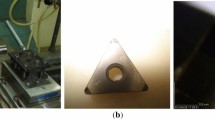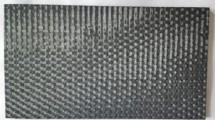Abstract
The morphology, depth, and distribution of subsurface damage (SSD) on glass BK7 specimens produced in rotary ultrasonic machining (RUM) and conventional grinding (CG) processes with three diamond tools were investigated. The ultrasonic effects on the SSD characteristics were also explored with respect to the material removal mechanisms and the specific kinematics principles of the abrasives. The experimental results demonstrated that the increased cutting velocity would improve the subsurface qualities, while the increased feed speed and cutting depth would deteriorate SSD depth of the RUM/CG specimens. Superimposition with the ultrasonic vibration increased the maximum cutting depth of each abrasive by an amplitude and also resulted in the cyclical variation in abrasive trajectories, hereby worsening the SSD depth of the final RUM surfaces. A large amount of incipient cracks which pulverized the material were just concentrated on the top RUM surface, thus increasing the subsurface crack distributions. With the abrasive moving ahead, these incipient cracks would propagate forward, hereby hindering the nucleation of the fresh cracks, and decreasing the subsurface crack obscurations of the RUM surface at a local level. Some rogue cracks were occasionally found to be located in deeper subsurface of the RUM/CG specimens, and the mutual interactions between the adjacent abrasive indentations would promote the propagations of the subsurface cracks, which gave rise to the nucleation of these rogue cracks.
Similar content being viewed by others
References
P.P Hed, D.F. Edwards, Relationship between subsurface damage depth and surface roughness during grinding of optical glass with diamond tools, Appl. Opt. 26 (1987) 2491
Li S, Wang Z, Wu Y (2008) Relationship between subsurface damage and surface roughness of optical materials in grinding and lapping processes. J Mater Process Tech 205:34–41
Wang J, Li Y (2011) Evaluating subsurface damage in optical glasses. J Eur Opt Soc-Rapid 6:11001
Helbawi H, Zhang L, Zarudi I (2001) Difference in subsurface damage in indented specimens with and without bonding layer. Int J Mech Sci 43:1107–1121
Lv D, Huang Y, Tang Y, Wang H (2013) Relationship between subsurface damage and surface roughness of glass BK7 in rotary ultrasonic machining and conventional grinding processes. Int J Adv Manuf Technol 67:613–622
Randi JA, Lambropoulos JC, Jacobs SD (2005) Subsurface damage in some single crystalline optical materials. Appl Opt 44:2241–2249
Miller PE, Suratwala TI, Wong LL, Feit MD, Menapace JA, Davis PJ, Steele RA (2005) The distribution of subsurface damage in fused silica. Proc SPIE 5991:1–25
Yoshikawa M, Zhang B, Tokura H (1987) Observations of ceramics surface cracks by newly proposed methods. J Ceram Soc Jpn 95:961–969 (in Japanese)
Wong L, Suratwala T, Feit MD, Miller PE, Steele R (2009) The effect of HF/NH4F etching on the morphology of surface fractures on fused silica. J Non-Crystal Solids 355:797–810
Liao ZM, Cohen SJ, Taylor JR (1995) Total internal reflection microscopy (TIRM) as a nondestructive subsurface damage assessment tool. Proc SPIE 2428:43–53
Winn J, Yeomans JA (1996) A study of microhardness indentation fracture in alumina using confocal scanning laser microscopy. Philos Mag A 74:1253–1263
Wuttig A, Steinert J, Duparre A, Truckenbrodt H (1999) Surface roughness and subsurface damage characterization of fused silica substrates. Proc SPIE 3739:369–376
Li Y, Huang H, Xie R, Li H, Deng Y, Chen X, Wang J, Xu Q, Yang W, Guo Y (2010) A method for evaluating subsurface damage in optical glass. Opt Express 18:17180–17186
Suratwala T, Wong L, Miller P, Feit MD, Menapace J, Steele R, Davis P, Walmer D (2006) Sub-surface mechanical damage distributions during grinding of fused silica. J Non-Cryst Solids 352:5601–5617
Wang Z, Wu Y, Dai Y, Li S (2008) Subsurface damage distribution in the lapping process. Appl Opt 47:1417–1426
Lv D, Wang H, Tang Y, Huang Y, Zhang H, Ren W (2012) Surface observations and material removal mechanisms in rotary ultrasonic machining of brittle material. Proc IMechE Part B: J Eng Manu 226:1479–1488
Qu W, Wang K, Miller MH, Huang Y, Chandra A (2000) Using vibration-assisted grinding to reduce subsurface damage. Precis Eng 24:329–337
Li Y, Zheng N, Li H, Hou J, Lei X, Chen X, Yuan Z, Guo Z, Wang J, Guo Y, Xu Q (2011) Morphology and distribution of subsurface damage in optical fused silica parts: Bound-abrasive grinding. Appl Surf Sci 257:2066–2073
M. Buijs, K,K. Houten, Three-body abrasion of brittle materials as studied by lapping, Wear 166 (1993) 237–245
Suratwala T, Steele R, Feit MD, Wong L, Miller P, Menapace J, Davis P (2008) Effect of rogue particles on the sub-surface damage of fused silica during grinding polishing. J Non-Cryst Solids 354:2023–2037
Zhou X, Xi F (2002) Modeling and predicting surface roughness of the grinding process. Int J Mach Tool Manu 42:969–977
Malkin S, Hwang TW (1996) Grinding mechanisms for ceramics. Ann CIRP 45:569–580
Buijs M, Martens LAAG (1992) Effect of indentation interaction on cracking. J Am Ceram Soc 75:2809–2814
Author information
Authors and Affiliations
Corresponding author
Rights and permissions
About this article
Cite this article
Lv, D., Wang, H., Zhang, W. et al. Subsurface damage depth and distribution in rotary ultrasonic machining and conventional grinding of glass BK7. Int J Adv Manuf Technol 86, 2361–2371 (2016). https://doi.org/10.1007/s00170-016-8376-z
Received:
Accepted:
Published:
Issue Date:
DOI: https://doi.org/10.1007/s00170-016-8376-z




